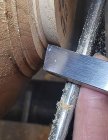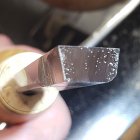The recent thread on twice turned bowls made me wonder how reliable/accurate the returned tenon is for folks.
In other words, if you true the tenon and turn the outside of the bowl in one step, when you reverse and put the tenon in your chuck, is the outside adequately true?
Please input to our survey:
1. What percentage of the time can you accept the outside turning and what percentage of the time do you have to re-true the outside?
(for full data collection, 2. what do you use to drive the inside of the bowl? and 3. what chuck do you use?)
Thanks.
In other words, if you true the tenon and turn the outside of the bowl in one step, when you reverse and put the tenon in your chuck, is the outside adequately true?
Please input to our survey:
1. What percentage of the time can you accept the outside turning and what percentage of the time do you have to re-true the outside?
(for full data collection, 2. what do you use to drive the inside of the bowl? and 3. what chuck do you use?)
Thanks.


